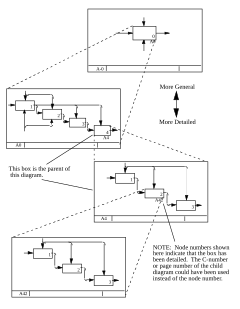Structured analysis and design technique

Structured Analysis and Design Technique (SADT) is a software engineering methodology for describing systems as a hierarchy of functions.
Overview
Structured Analysis and Design Technique (SADT) is a diagrammatic notation designed specifically to help people describe and understand systems.[1] It offers building blocks to represent entities and activities, and a variety of arrows to relate boxes. These boxes and arrows have an associated informal semantics.[2] SADT can be used as a functional analysis tool of a given process, using successive levels of details. The SADT method not only allows one to define user needs for IT developments, which is often used in the industrial Information Systems, but also to explain and present an activity’s manufacturing processes and procedures.[3]
The SADT supplies a specific functional view of any enterprise by describing the functions and their relationships in a company. These functions fulfill the objectives of a company, such as sales, order planning, product design, part manufacturing, and human resource management. The SADT can depict simple functional relationships here and can reflect data and control flow relationships between different functions.
History
SADT has been developed and field-tested during the period of 1969 to 1973 by Douglas T. Ross and SofTech, Inc..[1][4] The methodology was used in the MIT Automatic Programming Tool (APT) project. It received extensive use starting in 1973 by the US Air Force Integrated Computer Aided Manufacturing program.
According to Levitt (2000) "it is part of a series of structured methods, that represent a collection of analysis, design, and programming techniques that were developed in response to the problems facing the software world from the 1960s to the 1980s. In this timeframe most commercial programming was done in COBOL and Fortran, then C and BASIC. There was little guidance on “good” design and programming techniques, and there were no standard techniques for documenting requirements and designs. Systems where getting larger and more complex, and the information system development became harder and harder to do so. As a way to help manage large and complex software. Since the end 1960 multiple Structured Methods emerged".[5]
- Structured programming in circa 1967 with Edsger W. Dijkstra.
- Structured Design around 1975 with Larry Constantine and Ed Yourdon
- Structured Analysis in circa 1978 with Tom DeMarco, Yourdon, Gane & Sarson, McMenamin & Palmer.
- Information Engineering in circa 1990 with James Martin.
In 1981 the IDEF0 formalism was published, based on SADT.[6]
SADT topics


Top down approach
The structured analysis and design technique uses a decomposition with the top-down approach. This decomposition is conducted only in the physical domain from an axiomatic design viewpoint. Because of this nonzigzagging process, there is no guarantee of functionality or productivity. Therefore, those methods faded away as the requirements for software systems increased and the object-oriented method was introduced.[7]
Diagrams
SADT uses two types of diagrams: activity models and data models. It uses arrows to build these diagrams. The SADT’s representation is the following:
- A main box where the name of the process or the action is specified
- On the left-hand side of this box, incoming arrows: inputs of the action.
- On the upper part, the incoming arrows: data necessary for the action.
- On the bottom of the box, incoming arrows: means used for the action.
- On the right-hand side of the box, outgoing arrows: outputs of the action.
The semantics of arrows for activities:[2]
- Inputs enter from the left and represent data or consumables that are needed by the activity.
- Outputs exit from the right and represent data or products that are produced by the activity.
- Controls enter from the top and represent commands which influence the execution of an activity but are not consumed.
- Mechanisms identify the means, components or tools used to accomplish the activity. Represents allocation of activities.
The semantics of arrows for data:[2]
- Inputs are activities that produce the data.
- Outputs consume the data.
- Controls influence the internal state of the data.
See also
- IDEF0
- Jackson Structured Programming
- Structure chart
- Structured Systems Analysis and Design Method
- Systems analysis
References
- ^ a b D. Marca, C. McGowan, Structured Analysis and Design Technique, McGraw-Hill, 1987, ISBN 0-07-040235-3
- ^ a b c John Mylopoulos (2004). Conceptual Modelling III. Structured Analysis and Design Technique (SADT). Retrieved 21 September 2008.
- ^ SADT at Free-logisitcs.com. Retrieved 21 September 2008.
- ^ D. T. Ross: Structured Analysis (SA): A Language for Communicating Ideas. IEEE Transactions on Software Engineering, SE-3(1), pp. 16-34. Abstract
- ^ Dave Levitt (2000):Introduction to Structured Analysis and Design. Retrieved 21 September 2008.
- ^ Gavriel Salvendy (2001). Handbook of Industrial Engineering: Technology and Operations Management.. p.508.
- ^ Nam Pyo Suh (2007). Axiomatic Design - Advances and Applications. New York : Oxford University Press Chapter 5, pp. 239-298.
Further reading
- William S. Davis (1992). Tools and Techniques for Structured Systems Analysis and Design. Addison-Wesley. ISBN 0-201-10274-9
- Marca, D.A., and C.L. McGowan. (1988). SADT: structured analysis and design technique. McGraw-Hill Book Co., Inc.: New York, NY.
- Jerry FitzGerald and Ardra F. FitzGerald (1987). Fundamentals of Systems Analysis: Using Structured Analysis and Design Techniques. Wiley. ISBN 0-471-88597-5
- David A. Marca and Clement L. McGowan (1988). SADT: Structured Analysis and Design Technique. McGraw-Hill. ISBN 0-07-040235-3
- D. Millington (1981). Systems Analysis and Design for Computer Applications. E. Horwood. ISBN 0-85312-249-0
- Robertson & Robertson (1999). Mastering the Requirements Process. Addison Wesley.
- James C. Wetherbe (1984). Systems Analysis and Design: Traditional, Structured, and Advanced Concepts and Techniques. West Pub. Co. ISBN 0-314-77858-6
External links
